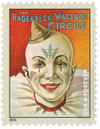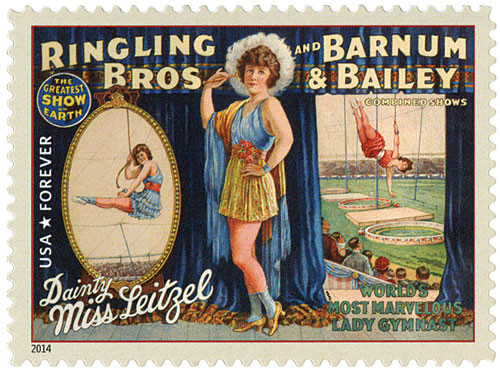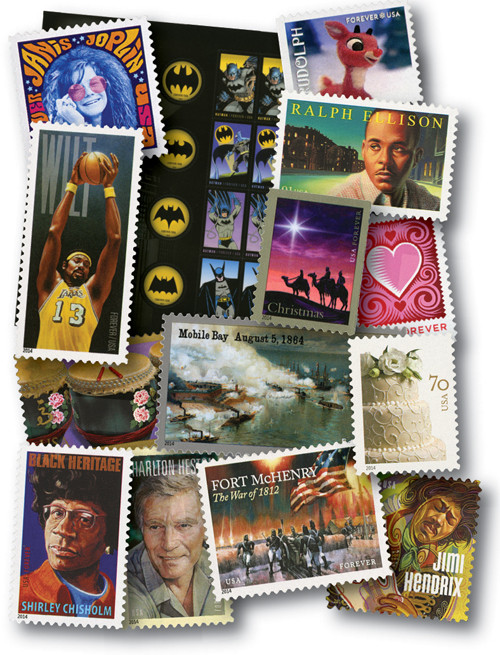
2014 First-Class Forever Stamp,Vintage Circus Posters: Hagenbeck-Wallace Circus, Clown
# 4905 - 2014 First-Class Forever Stamp - Vintage Circus Posters: Hagenbeck-Wallace Circus, Clown
$1.25 - $5.25
U.S. #4905
2014 49¢ Carl Hagenbeck-Wallace Circus
Vintage Circus Posters
This stamp is one of eight designs included in the Vintage Circus Posters stamps. Each pane includes stamps in two sizes: large horizontal stamps (2” X 1.46”) and smaller vertical stamps (1.12” X 1.46”).
From ancient mimes, mimics, and fools to medieval court jesters and pantomimes to modern comedians and clowns, comic relief has always been a welcome part of any show.
Clowns have been a major part of the circus since circuses as we know them began. When the first modern circus opened in London, it featured mostly horse-riding tricks by a sole performer. The crowd needed entertainment in between stunts, and comics were hired to fill the gap. The circus clown was born.
By the early 1800s, pantomime comic Joseph Grimaldi had done away with masks in favor of white face paint like that used in ancient Greek theatre and by jesters of the Middle Ages. The white face and exaggerated, painted-on facial features amplified the clowns’ expressions, making every smile and frown visible to the last row in the arena. English circus comics quickly adopted this look and the trend carried over to the United States.
Today, the well-known “whiteface” can be either classic, with proportionate features signifying a more intelligent clown, or grotesque, with exaggerated and comedic features, emphasizing a degree of zaniness in the clown. Regardless of overall appearance, both types are intended to enhance the clown’s natural features, which are his main tool in the trade.
The Vintage Circus Poster stamps were designed to look like circus posters of the 19th century. Some of these original posters were big enough to cover the side of a building and they advertised that the circus was coming to town.
49¢ Vintage Circus Posters, issued to satisfy the first-class mail rate
Issue Date: May 5, 2014
City: Sarasota, FL, at the John and Mable Ringling Museum of Art
Category: Commemorative
Quantity: 7,500,000
Printed By: Banknote Corporation of America for Sennett Security Products
Printing Method: Lithographed, sheets of 96 with six panes of 16 per sheet
Perforations: Serpentine Die Cut 11
Self-adhesive
U.S. #4905
2014 49¢ Carl Hagenbeck-Wallace Circus
Vintage Circus Posters
This stamp is one of eight designs included in the Vintage Circus Posters stamps. Each pane includes stamps in two sizes: large horizontal stamps (2” X 1.46”) and smaller vertical stamps (1.12” X 1.46”).
From ancient mimes, mimics, and fools to medieval court jesters and pantomimes to modern comedians and clowns, comic relief has always been a welcome part of any show.
Clowns have been a major part of the circus since circuses as we know them began. When the first modern circus opened in London, it featured mostly horse-riding tricks by a sole performer. The crowd needed entertainment in between stunts, and comics were hired to fill the gap. The circus clown was born.
By the early 1800s, pantomime comic Joseph Grimaldi had done away with masks in favor of white face paint like that used in ancient Greek theatre and by jesters of the Middle Ages. The white face and exaggerated, painted-on facial features amplified the clowns’ expressions, making every smile and frown visible to the last row in the arena. English circus comics quickly adopted this look and the trend carried over to the United States.
Today, the well-known “whiteface” can be either classic, with proportionate features signifying a more intelligent clown, or grotesque, with exaggerated and comedic features, emphasizing a degree of zaniness in the clown. Regardless of overall appearance, both types are intended to enhance the clown’s natural features, which are his main tool in the trade.
The Vintage Circus Poster stamps were designed to look like circus posters of the 19th century. Some of these original posters were big enough to cover the side of a building and they advertised that the circus was coming to town.
49¢ Vintage Circus Posters, issued to satisfy the first-class mail rate
Issue Date: May 5, 2014
City: Sarasota, FL, at the John and Mable Ringling Museum of Art
Category: Commemorative
Quantity: 7,500,000
Printed By: Banknote Corporation of America for Sennett Security Products
Printing Method: Lithographed, sheets of 96 with six panes of 16 per sheet
Perforations: Serpentine Die Cut 11
Self-adhesive












